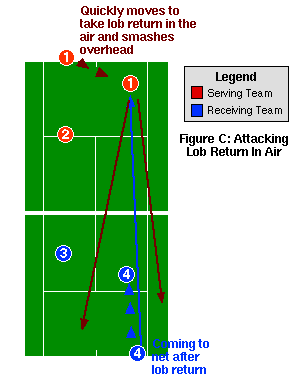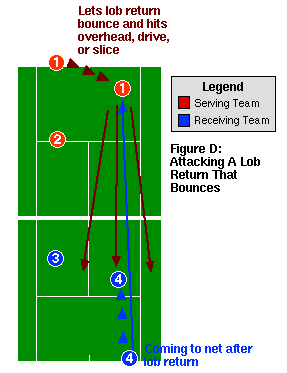<% ns_puts [nsv_get mkm_includes mkm_oldContentHeader_inc] %>
Strategy Lesson
of the Week
Handling the Lob Return in Doubles:
Part 3: Attacking
By Monty Basynat, TennisONE Editor
Attacking the Lob Return
 Once you see that your opponents are resorting to the lob return over again and again, you can either stay back
or fake coming into the net behind your serve (in Part 1 we
covered your net partner's standing deeper to take the lob volley).
In both cases you should think taking the lob return in the air and quickly
moving over to hit an overhead smash. A smash at Player #3 would not be
advisable, as this player is set and prepared at the net. The safer choice
would be to hit the ball between Player #3 or into Player #4's (who may
be on the way up to net) side of the court. One word of warning: this
strategy option is much more feasible when the lob return is to the server's
forehand. Executing this play may be difficult if you are moving
to your backhand side. This would mean you would have to run 2-3 more steps
and pivot your body so you're ready to hit this overhead.
Once you see that your opponents are resorting to the lob return over again and again, you can either stay back
or fake coming into the net behind your serve (in Part 1 we
covered your net partner's standing deeper to take the lob volley).
In both cases you should think taking the lob return in the air and quickly
moving over to hit an overhead smash. A smash at Player #3 would not be
advisable, as this player is set and prepared at the net. The safer choice
would be to hit the ball between Player #3 or into Player #4's (who may
be on the way up to net) side of the court. One word of warning: this
strategy option is much more feasible when the lob return is to the server's
forehand. Executing this play may be difficult if you are moving
to your backhand side. This would mean you would have to run 2-3 more steps
and pivot your body so you're ready to hit this overhead.
 Perhaps it's the case you can't take
the lob return in the air. If the lob is extremely deep, you will probably
have to let it bounce and opt for one of the defensive plays outlined previously.
But sometimes the lob return is shallow enough and bounces up high enough--or
centered in the middle of the court--that it allows you to smash it with
an overhead. The key here is that you must move into position very
quickly to smash this bouncing lob because often the bounce is fairly low.
Again, it's much easier to execute the overhead smash of the lob return
if the lob is to your forehand side. A weak and shallow lob return might
also allow you to drive the ball at Player #4 or more likely (since this
is generally a high bouncing ball) hit a cut or slice shot at Player #4's
feet or down Player #4's alley. However, when in doubt, the safer attacking
play is to direct our shot the ball between Player #3 and Player #4. You
should definitely avoid driving the ball at Player #3, who should be set
and prepared at the net to answer your shot with a winning volley.
Perhaps it's the case you can't take
the lob return in the air. If the lob is extremely deep, you will probably
have to let it bounce and opt for one of the defensive plays outlined previously.
But sometimes the lob return is shallow enough and bounces up high enough--or
centered in the middle of the court--that it allows you to smash it with
an overhead. The key here is that you must move into position very
quickly to smash this bouncing lob because often the bounce is fairly low.
Again, it's much easier to execute the overhead smash of the lob return
if the lob is to your forehand side. A weak and shallow lob return might
also allow you to drive the ball at Player #4 or more likely (since this
is generally a high bouncing ball) hit a cut or slice shot at Player #4's
feet or down Player #4's alley. However, when in doubt, the safer attacking
play is to direct our shot the ball between Player #3 and Player #4. You
should definitely avoid driving the ball at Player #3, who should be set
and prepared at the net to answer your shot with a winning volley.
Conclusion
The lob return can be a potent weapon in doubles. It can discourage the
serving team from coming to the net behind their serve and it can give the
receiving team the upper hand strategically by allowing them to seize control
of the net. Your job as a doubles team is to understand how this weapon
works and to figure out how to attack it if you can and how to defend against
it if you can't.
Send in Your Strategy Questions to TennisONE
If you think you have a good TennisONE Strategy Question, please send an
email to: question@tennisone.com.
<% ns_puts [nsv_get mkm_includes mkm_oldContentFooter_inc] %>
 Once you see that your opponents are resorting to the lob return over again and again, you can either stay back
or fake coming into the net behind your serve (in Part 1 we
covered your net partner's standing deeper to take the lob volley).
In both cases you should think taking the lob return in the air and quickly
moving over to hit an overhead smash. A smash at Player #3 would not be
advisable, as this player is set and prepared at the net. The safer choice
would be to hit the ball between Player #3 or into Player #4's (who may
be on the way up to net) side of the court. One word of warning: this
strategy option is much more feasible when the lob return is to the server's
forehand. Executing this play may be difficult if you are moving
to your backhand side. This would mean you would have to run 2-3 more steps
and pivot your body so you're ready to hit this overhead.
Once you see that your opponents are resorting to the lob return over again and again, you can either stay back
or fake coming into the net behind your serve (in Part 1 we
covered your net partner's standing deeper to take the lob volley).
In both cases you should think taking the lob return in the air and quickly
moving over to hit an overhead smash. A smash at Player #3 would not be
advisable, as this player is set and prepared at the net. The safer choice
would be to hit the ball between Player #3 or into Player #4's (who may
be on the way up to net) side of the court. One word of warning: this
strategy option is much more feasible when the lob return is to the server's
forehand. Executing this play may be difficult if you are moving
to your backhand side. This would mean you would have to run 2-3 more steps
and pivot your body so you're ready to hit this overhead.
 Perhaps it's the case you can't take
the lob return in the air. If the lob is extremely deep, you will probably
have to let it bounce and opt for one of the defensive plays outlined previously.
But sometimes the lob return is shallow enough and bounces up high enough--or
centered in the middle of the court--that it allows you to smash it with
an overhead. The key here is that you must move into position very
quickly to smash this bouncing lob because often the bounce is fairly low.
Again, it's much easier to execute the overhead smash of the lob return
if the lob is to your forehand side. A weak and shallow lob return might
also allow you to drive the ball at Player #4 or more likely (since this
is generally a high bouncing ball) hit a cut or slice shot at Player #4's
feet or down Player #4's alley. However, when in doubt, the safer attacking
play is to direct our shot the ball between Player #3 and Player #4. You
should definitely avoid driving the ball at Player #3, who should be set
and prepared at the net to answer your shot with a winning volley.
Perhaps it's the case you can't take
the lob return in the air. If the lob is extremely deep, you will probably
have to let it bounce and opt for one of the defensive plays outlined previously.
But sometimes the lob return is shallow enough and bounces up high enough--or
centered in the middle of the court--that it allows you to smash it with
an overhead. The key here is that you must move into position very
quickly to smash this bouncing lob because often the bounce is fairly low.
Again, it's much easier to execute the overhead smash of the lob return
if the lob is to your forehand side. A weak and shallow lob return might
also allow you to drive the ball at Player #4 or more likely (since this
is generally a high bouncing ball) hit a cut or slice shot at Player #4's
feet or down Player #4's alley. However, when in doubt, the safer attacking
play is to direct our shot the ball between Player #3 and Player #4. You
should definitely avoid driving the ball at Player #3, who should be set
and prepared at the net to answer your shot with a winning volley.